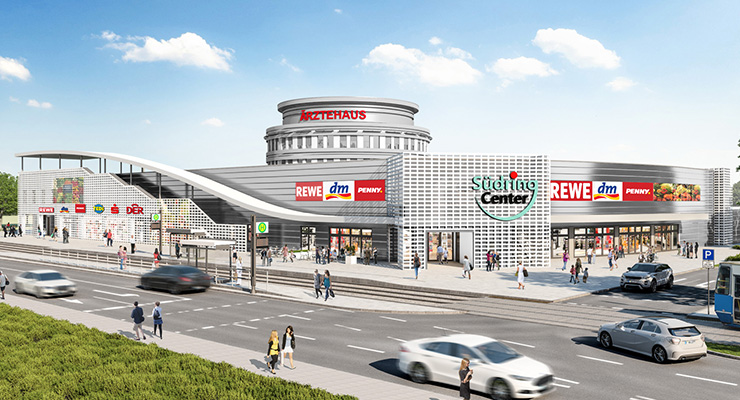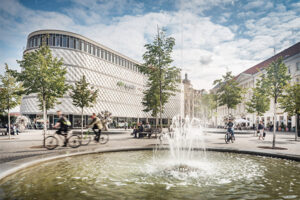Through the increasing usage of mixed-use solutions, municipalities are not only making the most of the limited space available and promoting the 15-minute city model, but the locations are also more sustainable and economical this way and they help cities and municipalities achieve their climate targets. This is shown in the second GRR Basic Retail Report (in German), which GRR Group together with their cooperation partner Savills has presented in Nuremberg, Germany.
Basic retail undertakes responsibility
“Local suppliers are now an integral part of urban development in integrated locations. In the future, we will see fewer and fewer single locations in metropolitan areas. Mixed-use properties fit well into the GRR Group’s ESG strategy because living, working, and shopping under one roof enable short distances to be covered while consuming very little space. The GRR Report shows how mixed-use properties can make neighborhoods and urban districts more livable and improve the climate balance,” explains Martin Führlein, CEO of the GRR Group.
The portfolio of mixed-use properties predicted to grow
For the report, GRR Group surveyed retail experts and investors in mid-2022 to gauge sentiment on market trends, the importance of retail mixed-use properties, and their ESG strategy. The investment focus of the respondents can currently still be classified as risk-averse. The focus is on Core and Core+ properties. This orientation is not expected to change in the next three years.
About half of the investors surveyed have food-anchored RMU properties in their portfolios. Forty percent plan to expand their RMU holdings in the coming years. Investors prefer properties in cities with populations of 50,000 or more. Small communities, on the other hand, play no role for RMUs. More than two-thirds, and thus the majority of investors, would pursue a core strategy with an RMU fund. The respondents see the greatest advantage in RMU properties due to the diversification of their portfolio, and also in synergy effects resulting from mixed-use. The risk-reducing effect for the real estate portfolio as a whole is also cited as an advantage of RMU properties.
From an ESG perspective, the (re)use of properties as retail mixed-use properties is welcomed. “The promotion of urban centers through neighborhoods designed in this way leads, through shortened distances and the retention of existing properties, to a reduction in CO2 emissions. At the same time, the multi-functionality of these centers causes residents to identify with their neighborhood and develop a bond with it. This can encourage active participation in shaping the urban space,” explains Dr. Astrid Keller, ESG and Research Manager at GRR Group.
Investors focus on ecological criteria
ESG standards are playing an increasingly important role in investor decisions. Environmental criteria (E-Environment) are enjoying the greatest attention out of them all. To be sure, fund products that do not have Article 8 or 9 predicates continue to be underwritten. However, only one-third still see no need to gear their investment strategy according to Article 8 or 9 funds.
However, people are nowadays still relaxed about building certifications. For approximately half of those surveyed, building certifications are still unimportant. In the future, however, greater attention will be paid to certified buildings. For 90 percent of respondents, these will be rather important or very important in the future. This is because, according to the investors surveyed, building certifications primarily help to increase the market value of the building. However, many do not see a significant increase in rent levels.
For tenants, a noticeable reduction in operating costs is expected as a result of more sustainable buildings, but investors or owners expect a significant increase in the documentation effort.
Uniform ESG standards are lacking
It has become clear from the survey of investors that the real estate industry is aware of the challenges of climate change and the need for decarbonization. However, there is a lack of clear ESG standards for the real estate industry to follow. At the same time, nearly half (42%) see the increased reporting burden as a major challenge.
GRR Group focuses on sustainability
GRR Group has picked up on the trend with GRR Future Retail Properties 1 (in German), a new fund launched in the summer. The fund, with an investment volume of 350 million euros and an equity portion of 200 million euros, is designed as a special AIF for institutional investors and exclusively acquires properties in the food retail sector that meet verifiable ESG criteria.
The requirements under Art. 8 of the Disclosure Regulation are thus met. For monitoring purposes, a proprietary ESG scoring model has been developed with an external consulting firm, with the GRR Future Retail Properties 1 particularly targeting an environmental aspect, namely the improvement of climate protection.
GRR Basic Retail Report
Upon request, GRR Group is pleased to provide the complete “GRR Basic Retail Report 2022” (in German). In it, around 30 renowned experts shed light on all aspects of retail-mixed-use real estate.






